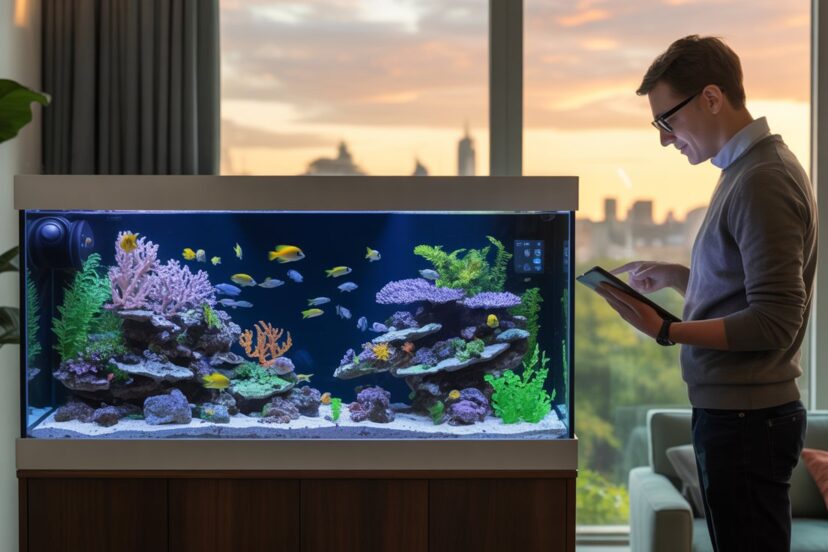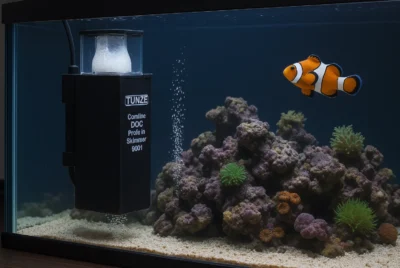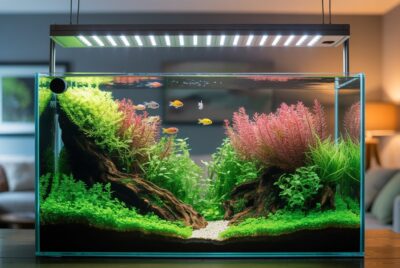Voice-Controlled Aquariums: The Future of Smart Aquatic Care
*We may earn a commission for purchases made using our links. Please see our disclosure to learn more.
Picture this: You’re rushing out the door for work when you suddenly remember you forgot to feed your fish. Instead of turning back, you simply call out, “Feed the fish,” and your aquarium responds instantly. This isn’t science fiction anymore—it’s the reality of voice-controlled aquariums transforming how aquarists care for their aquatic companions.
The intersection of smart home technology and aquarium keeping has created revolutionary possibilities for both novice fish keepers and seasoned aquarists. Voice-controlled aquariums represent more than just convenience; they embody a fundamental shift toward intelligent, responsive aquatic ecosystems that can adapt, monitor, and maintain themselves with minimal human intervention.
“The future of aquarium keeping lies not just in maintaining beautiful aquatic displays, but in creating intelligent ecosystems that respond to both the needs of marine life and the lifestyle demands of modern aquarists.”
— Marine Technology Research Institute
Key Takeaways
- Convenience Revolution: Voice commands eliminate the need for manual aquarium controls, making fish care accessible to people with mobility challenges or busy schedules
- Precision Care: Smart sensors provide real-time monitoring of water parameters, temperature, and feeding schedules with voice-activated adjustments
- Emergency Response: Automated alerts and voice notifications help prevent aquatic disasters before they occur
- Integration Benefits: Voice-controlled systems seamlessly connect with existing smart home ecosystems for comprehensive automation
- Learning Capability: Advanced systems adapt to your fish’s behavior patterns and optimize care routines through AI-driven insights
Recommended Voice-Controlled Aquarium Products
GLOWRIUM Saltwater Aquarium Light
The GLOWRIUM Saltwater Aquarium Light is a cutting-edge LED lighting system designed for vibrant coral and fish growth. Featuring six-channel full-spectrum lighting (including Cool White, Blue, Violet, UVA, and Red), it replicates natural ocean conditions. With dual Bluetooth + WiFi control via a smart app, you can manage the light's spectrum, brightness, and schedule remotely—even if offline. The DIY spectrum settings allow you to fine-tune each channel to meet your coral’s needs. Plus, the integrated real-time water temperature sensor monitors your tank's environment and sends alerts if levels fluctuate. Built with durable aluminum and an anti-drop design, it’s a reliable upgrade for any saltwater aquarium enthusiast.
This Bluetooth + Wi-Fi enabled LED light system offers app control for customizable spectrum, brightness, and schedules. Features full-spectrum lighting, sunrise/sunset simulation, and a real-time water temperature sensor for coral health and fish care.
- Smart Control: Dual Bluetooth + WiFi app for easy remote management and customization.
- Full-Spectrum Lighting: Customizable 6-channel LED spectrum ensures coral health and vibrant colors.
- Temperature Monitoring: Real-time water temperature sensor with alert notifications for tank safety.
- Complex Setup: Initial configuration with app and device pairing may require some time.
- Price Point: Higher upfront cost compared to basic aquarium lights.
- Size Options: Limited to select tank sizes, may not fit all setups.
kactoily Smart Aquarium Water Monitor
This upgraded Smart Aquarium Water Monitor offers precise, real-time monitoring of multiple water parameters, including salinity, pH, ORP, TDS, EC, and temperature. Designed for both freshwater and saltwater tanks, it features a smaller, more stable probe with titanium-coated electrodes and automatic temperature compensation. With universal installation options, it adapts easily to any aquarium setup. The app-enabled system delivers 24/7 alerts via SMS or app notifications, helping you maintain a healthy aquatic environment. Triple-point calibration with included pH powders ensures industry-leading accuracy for all tank types.
Comprehensive aquarium monitoring system that tracks pH, salinity, ORP, temperature, and more with app-based real-time alerts. Offers universal installation, triple-point calibration, and delivers detailed tank health reports via smartphone integration.
- Accurate Monitoring: Tracks multiple parameters (pH, salinity, ORP, etc.) with high precision for optimal tank health.
- Smart Alerts: Sends real-time app and SMS notifications when water levels deviate from custom-set ranges.
- Versatile Installation: Can be fixed, suctioned, or free-floating for easy use in any aquarium.
- EC Calibration Solution Required: EC solution not included due to shipping regulations, sold separately.
- Higher Price: Premium price point may be a consideration for casual hobbyists.
- Complex Setup: Requires initial calibration and app configuration to function correctly.
BN-LINK Smart WiFi Digital Temperature Controller
The BN-LINK Smart WiFi Digital Temperature Controller offers precise heating and cooling management for your aquarium, reptile habitat, homebrew system, or greenhouse. With the free BN-LINK Smart app, you can remotely adjust temperature settings and monitor your environment from anywhere. Compatible with Alexa and Google Home, this controller enables voice-activated operation for added convenience. Dual digital outlets support simultaneous heating and cooling, while the waterproof sensor probe ensures reliable performance. Its safety features include overload protection and a durable three-prong grounded plug.
Precision temperature control with voice commands and smartphone connectivity. Features dual heating and cooling outlets, energy-efficient operation, and safety shut-off mechanisms for stable and safe environmental management.
- Voice Control: Integrates seamlessly with Alexa and Google Home for hands-free operation.
- Dual Functionality: Controls both heating and cooling devices simultaneously.
- Remote Monitoring: Access and manage temperature settings through the BN-LINK Smart app from anywhere.
- Wi-Fi Limitations: Only supports 2.4GHz Wi-Fi networks, not 5GHz.
- Initial Setup: Requires app configuration and network pairing, which may be complex for beginners.
- Size Constraints: Compact design may limit placement options in tight spaces.
PazkPuzk Smart Automatic Fish Feeder
Keep your fish well-fed and monitored with the PazkPuzk Smart Automatic Fish Feeder. This advanced feeder features dual food outlets, a built-in sensor, and a 2K camera with a wide-angle lens. Control feeding schedules remotely via the dedicated app, and keep your fish healthy even while you're away. Its sleek design ensures compatibility with most aquarium setups, making it a perfect addition to any home.
Voice-assisted fish feeder with remote scheduling and real-time camera monitoring. Provides portion control and customizable feeding plans to ensure consistent care, even when you’re away. Features dual food outlets and a desiccant system for optimal food quality.
- Custom Feeding Schedule: Plan feeding times and quantities via the app for precise, stress-free fish care.
- Dual Food Outlets: Supports various food sizes and prevents clogging, ensuring consistent feeding.
- 2K Camera Monitoring: Enjoy real-time aquarium views and share with friends using the wide-angle camera.
- Wi-Fi Dependency: Requires stable Wi-Fi for remote control and camera streaming.
- Limited Tank Compatibility: Mounting hardware may not fit thicker tank edges above 16.88 mm.
- Camera Resolution: While 2K, camera clarity may decrease in low light or murky water.
The Evolution of Smart Aquarium Technology
Traditional aquarium maintenance has long been a labor-intensive hobby requiring constant attention to water chemistry, feeding schedules, and equipment monitoring. The emergence of voice-controlled aquariums addresses these challenges through intelligent automation that responds to natural language commands while maintaining the personal connection between aquarists and their aquatic environments.
Understanding Voice-Controlled Aquarium Systems
Voice-controlled aquariums integrate multiple smart technologies to create responsive aquatic ecosystems. These systems typically include smart sensors for water quality monitoring, automated feeding mechanisms, intelligent lighting systems, and temperature control units—all managed through voice assistant integration.
Core Components of Smart Aquarium Systems:
The foundation of any voice-controlled aquarium begins with IoT sensors that continuously monitor critical parameters. Water quality sensors track pH levels, ammonia concentration, nitrite and nitrate levels, while temperature sensors ensure optimal thermal conditions. These sensors communicate with central control units that process voice commands and execute appropriate responses.
Smart feeding systems represent another crucial component, offering precise portion control and scheduling flexibility. Advanced feeders can distinguish between different fish species’ dietary requirements and adjust feeding protocols accordingly. Some systems even incorporate fish recognition technology to monitor individual feeding behavior and adjust portions based on consumption patterns.
Lighting control systems provide perhaps the most visually dramatic aspect of voice-controlled aquariums. These systems can simulate natural lighting cycles, enhance specific color spectrums for plant growth, and create ambient lighting effects that complement home décor while supporting aquatic life health.
The Journey from Manual to Voice-Activated Care
The transformation from traditional aquarium keeping to voice-controlled systems often begins with simple automation needs. Many aquarists first encounter smart technology through basic programmable timers for lighting or feeding systems. However, the convenience and precision of voice control quickly demonstrate the potential for comprehensive aquarium automation.
Overcoming Initial Technology Hesitation:
The transition to voice-controlled aquariums can feel overwhelming for traditional aquarists. Concerns about technology reliability, system complexity, and the fear of losing personal connection with aquatic pets are common. However, modern voice-controlled systems are designed with user-friendly interfaces that enhance rather than replace the human element in aquarium care.
Integration challenges often arise when connecting multiple smart devices within existing aquarium setups. Compatibility issues between different manufacturers’ products can create frustration, but standardized protocols like Wi-Fi and Bluetooth connectivity have largely resolved these concerns. Most contemporary voice-controlled aquarium systems offer plug-and-play installation with comprehensive mobile app support.
Practical Implementation Strategies
Starting Small with Smart Upgrades:
The most successful transitions to voice-controlled aquariums begin with incremental upgrades rather than complete system overhauls. Starting with a single smart component—such as a voice-controlled LED light system—allows aquarists to experience the convenience and reliability of smart technology without overwhelming complexity.
Water quality monitoring represents an excellent entry point for smart aquarium technology. Voice-activated pH and temperature monitoring provides immediate feedback on aquatic conditions while building confidence in automated systems. These foundational monitoring systems establish the data infrastructure necessary for more advanced automation features.
Advanced System Integration:
As comfort with voice-controlled technology grows, aquarists can expand into comprehensive ecosystem management. Advanced systems can coordinate feeding schedules with lighting cycles, adjust water temperature based on seasonal patterns, and even modify filtration intensity in response to bioload changes.
Multi-tank management becomes significantly more manageable with voice-controlled systems. Aquarists maintaining multiple aquariums can use centralized voice commands to monitor and adjust conditions across their entire collection. This scalability makes voice-controlled technology particularly valuable for serious aquarists or commercial aquaculture applications.
Addressing Common Smart Aquarium Challenges
Connectivity and Reliability Concerns:
Network connectivity represents the most common challenge with voice-controlled aquariums. Wi-Fi interruptions can temporarily disable voice control features, potentially causing anxiety about system reliability. However, most quality smart aquarium systems include local backup controls and battery-powered operation during network outages.
Regular software updates ensure optimal performance and security for voice-controlled aquarium systems. Some aquarists worry about update complexity, but modern systems typically handle updates automatically with minimal user intervention. Establishing routine update schedules helps maintain system reliability and access to new features.
Balancing Automation with Personal Engagement:
One concern among traditional aquarists involves maintaining personal connection with their aquatic environments. Voice-controlled systems can seem to create distance between aquarists and their fish, but properly implemented technology actually enhances observation and interaction opportunities.
Smart monitoring systems provide detailed insights into fish behavior patterns, feeding responses, and environmental preferences that manual observation might miss. Voice-controlled cameras allow for remote aquarium viewing, enabling continuous engagement even when physically absent.
The Emotional Impact of Smart Aquarium Technology
Stress Reduction and Peace of Mind:
Voice-controlled aquariums significantly reduce the stress associated with aquarium maintenance. The ability to check water parameters, adjust feeding schedules, or modify lighting conditions through simple voice commands eliminates many common aquarium-keeping anxieties.
Emergency notification systems provide immediate alerts for critical issues like equipment failures, temperature fluctuations, or water quality problems. These proactive warnings allow for rapid response to potential problems, often preventing aquatic disasters before they occur.
Enhanced Observation and Connection:
Contrary to concerns about technology creating distance, voice-controlled aquariums often strengthen the bond between aquarists and their aquatic environments. Detailed monitoring data reveals subtle behavior patterns and environmental preferences that enhance understanding of fish needs and personalities.
Time savings from automated maintenance tasks allow for more quality observation and interaction time. Rather than spending time on routine maintenance, aquarists can focus on observing fish behavior, planning aquascape modifications, or researching new species additions.
Environmental Considerations and Sustainability
Energy Efficiency Through Smart Controls:
Voice-controlled aquarium systems often incorporate energy-efficient technologies that reduce overall power consumption. Smart LED lighting systems can adjust intensity based on natural light conditions, while intelligent heaters maintain optimal temperatures with minimal energy waste.
Automated maintenance scheduling optimizes equipment runtime for maximum efficiency. Smart filtration systems can adjust flow rates based on bioload detection, while automated feeding systems prevent overfeeding that leads to water quality problems and increased filtration demands.
Water Conservation Benefits:
Advanced voice-controlled systems can monitor water usage and optimize water change schedules based on actual aquarium conditions rather than arbitrary timeframes. This precision approach to water management reduces waste while maintaining optimal aquatic environments.
Some smart systems integrate with home water monitoring to track and optimize overall aquarium-related water consumption. These insights help aquarists make informed decisions about water usage and conservation strategies.
Future Developments in Voice-Controlled Aquariums
Artificial Intelligence Integration:
The next generation of voice-controlled aquariums will incorporate artificial intelligence capabilities that learn from fish behavior patterns and environmental responses. These AI systems will predict maintenance needs, optimize feeding schedules, and suggest environmental modifications based on observed fish health and behavior.
Machine learning algorithms will enable voice-controlled systems to recognize individual fish and tailor care protocols accordingly. This personalization extends to understanding specific fish preferences, health patterns, and social dynamics within community aquariums.
Expanded Voice Assistant Integration:
Future voice-controlled aquarium systems will offer deeper integration with popular voice assistants, enabling more natural conversation patterns and complex command sequences. Rather than simple command-response interactions, aquarists will engage in conversational exchanges about aquarium conditions and care strategies.
Multi-language support and regional accent recognition will make voice-controlled aquariums accessible to diverse global communities. Cultural considerations in fish-keeping practices will be incorporated into voice command libraries and care recommendations.
Building Community Through Smart Technology
Sharing Experiences and Knowledge:
Voice-controlled aquarium systems often include social features that connect aquarists with broader communities. Sharing water parameter data, feeding schedules, and fish behavior observations creates valuable resources for other aquarium enthusiasts.
Remote monitoring capabilities allow experienced aquarists to mentor newcomers by providing real-time guidance and support. This virtual mentorship model expands access to expert knowledge and strengthens the aquarium-keeping community.
Collaborative Problem-Solving:
Smart aquarium systems can aggregate anonymized data across user networks to identify common problems and successful solutions. This collective intelligence helps individual aquarists benefit from community experiences and proven strategies.
Voice-controlled systems can provide access to expert consultation services, connecting aquarists with professional aquaculturists or veterinarians when complex problems arise. This integration of technology and expertise ensures optimal care for aquatic life.
Conclusion
Voice-controlled aquariums represent a fundamental evolution in aquatic care, combining technological innovation with traditional aquarium-keeping wisdom. These systems don’t replace the personal connection between aquarists and their fish; instead, they enhance that relationship by providing deeper insights, reducing maintenance stress, and creating more time for meaningful observation and interaction.
The journey toward smart aquarium technology begins with understanding your specific needs and starting with manageable upgrades. Whether addressing mobility challenges, managing multiple tanks, or simply seeking greater convenience, voice-controlled systems offer scalable solutions that grow with your aquarium-keeping journey.
As technology continues advancing, voice-controlled aquariums will become increasingly sophisticated, intuitive, and accessible. The future promises even greater integration between smart home systems and aquatic care, creating seamless environments where technology serves both human convenience and aquatic life welfare.
For aquarists ready to embrace this technological evolution, voice-controlled aquariums offer an exciting pathway toward more efficient, effective, and enjoyable aquatic care. The combination of automation, monitoring, and voice interaction creates aquarium-keeping experiences that are both cutting-edge and deeply personal.
Frequently Asked Questions
Q: Are voice-controlled aquariums safe for fish if the technology fails?
A: Quality voice-controlled aquarium systems include failsafe mechanisms and backup controls. Most systems continue basic operations (heating, filtration, oxygenation) even during connectivity issues, with manual override capabilities always available.
Q: How difficult is it to install voice-controlled aquarium equipment?
A: Modern smart aquarium systems are designed for easy installation with plug-and-play compatibility. Most components connect via standard aquarium fittings and require only basic Wi-Fi setup through smartphone apps.
Q: Can voice-controlled systems work with existing aquarium equipment?
A: Many voice-controlled systems are designed to integrate with existing aquarium setups. Smart outlets, adapters, and retrofit kits allow traditional equipment to be incorporated into voice-controlled systems without complete replacement.
Q: What happens to voice-controlled aquariums during power outages?
A: Most systems include battery backup for critical functions like oxygenation and basic monitoring. While voice control may be temporarily unavailable, essential life support systems typically continue operating during short power interruptions.
Q: Do voice-controlled aquariums require constant internet connectivity?
A: While internet connectivity enables full voice control features and remote monitoring, most systems include local control options. Basic functions like feeding, lighting, and temperature control often work without internet connection, though voice commands may be limited.
















